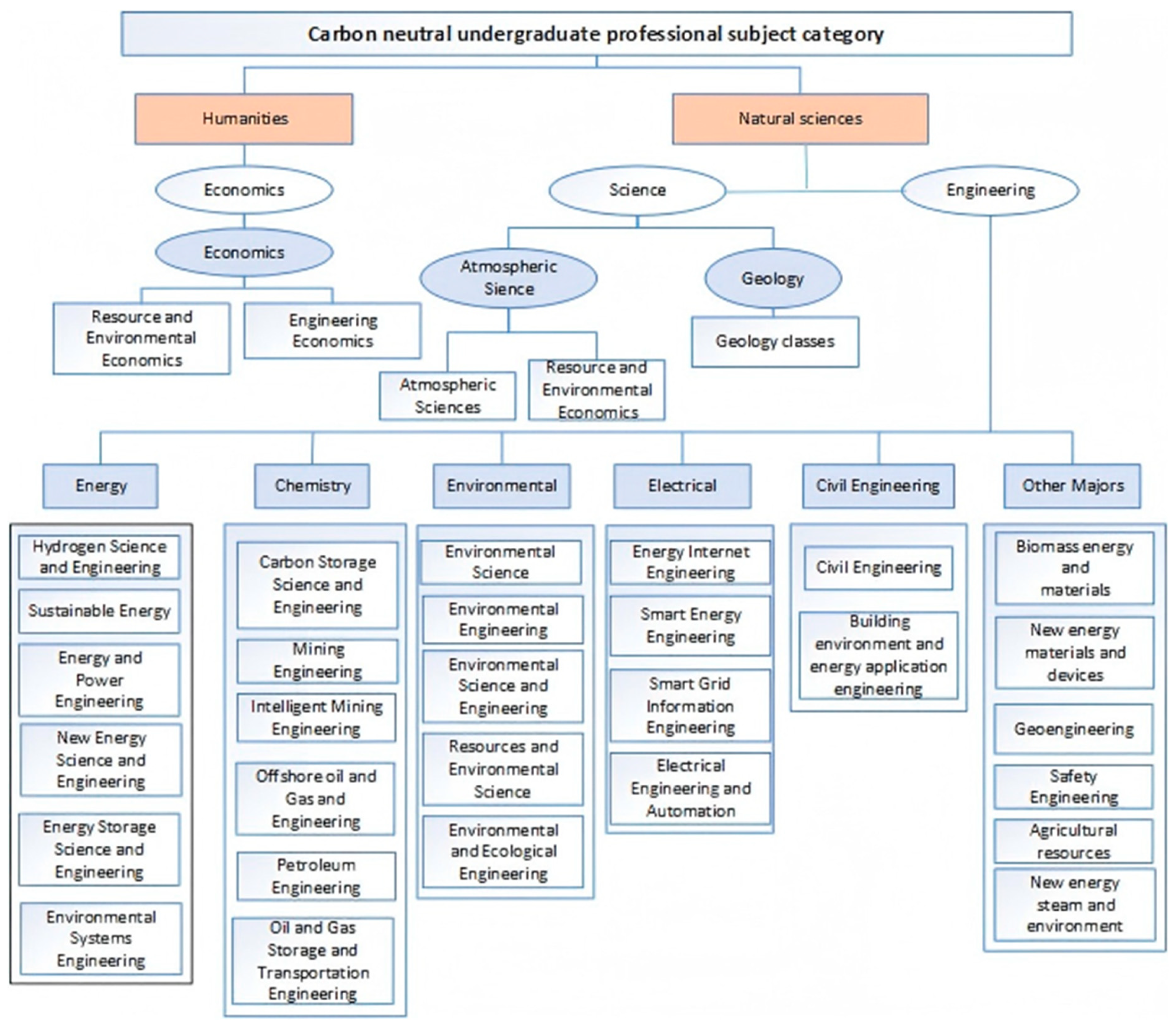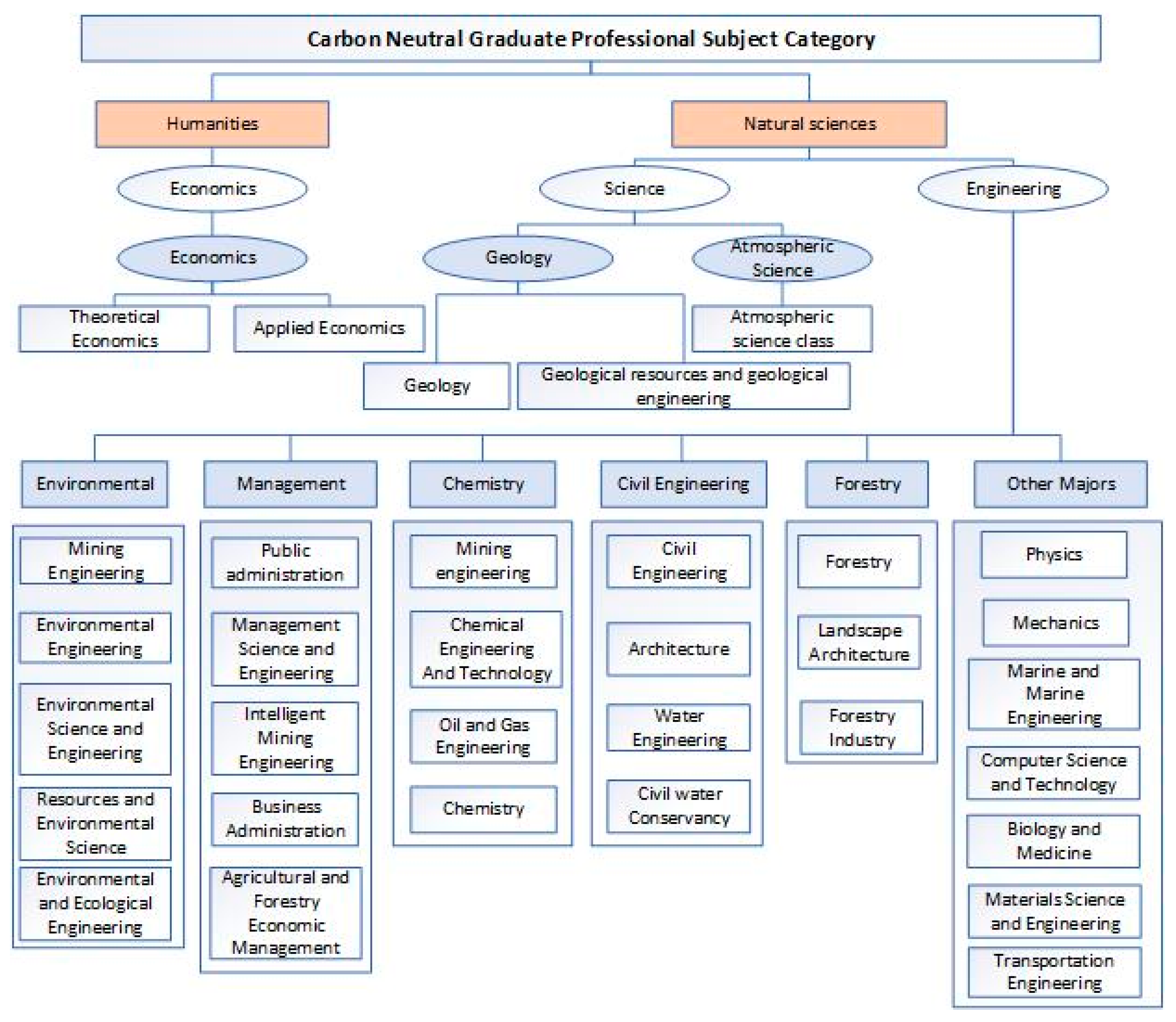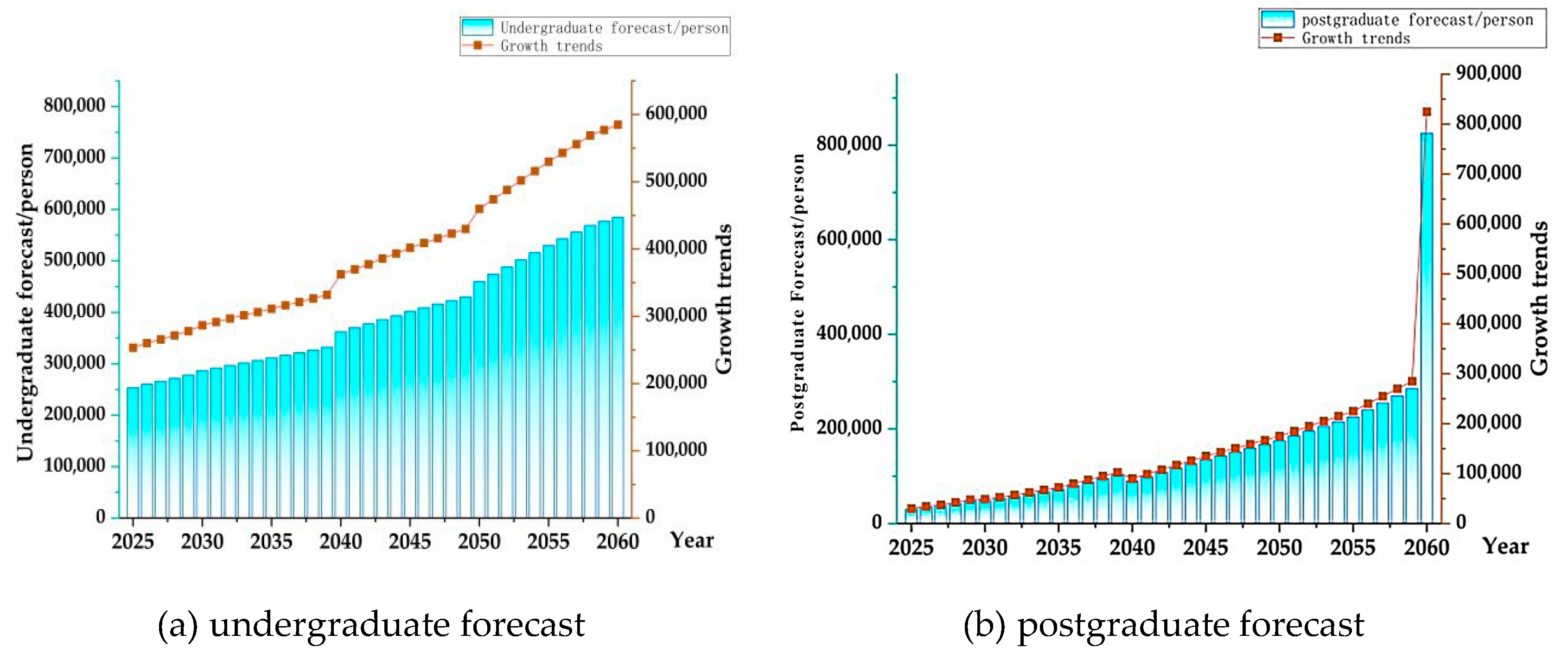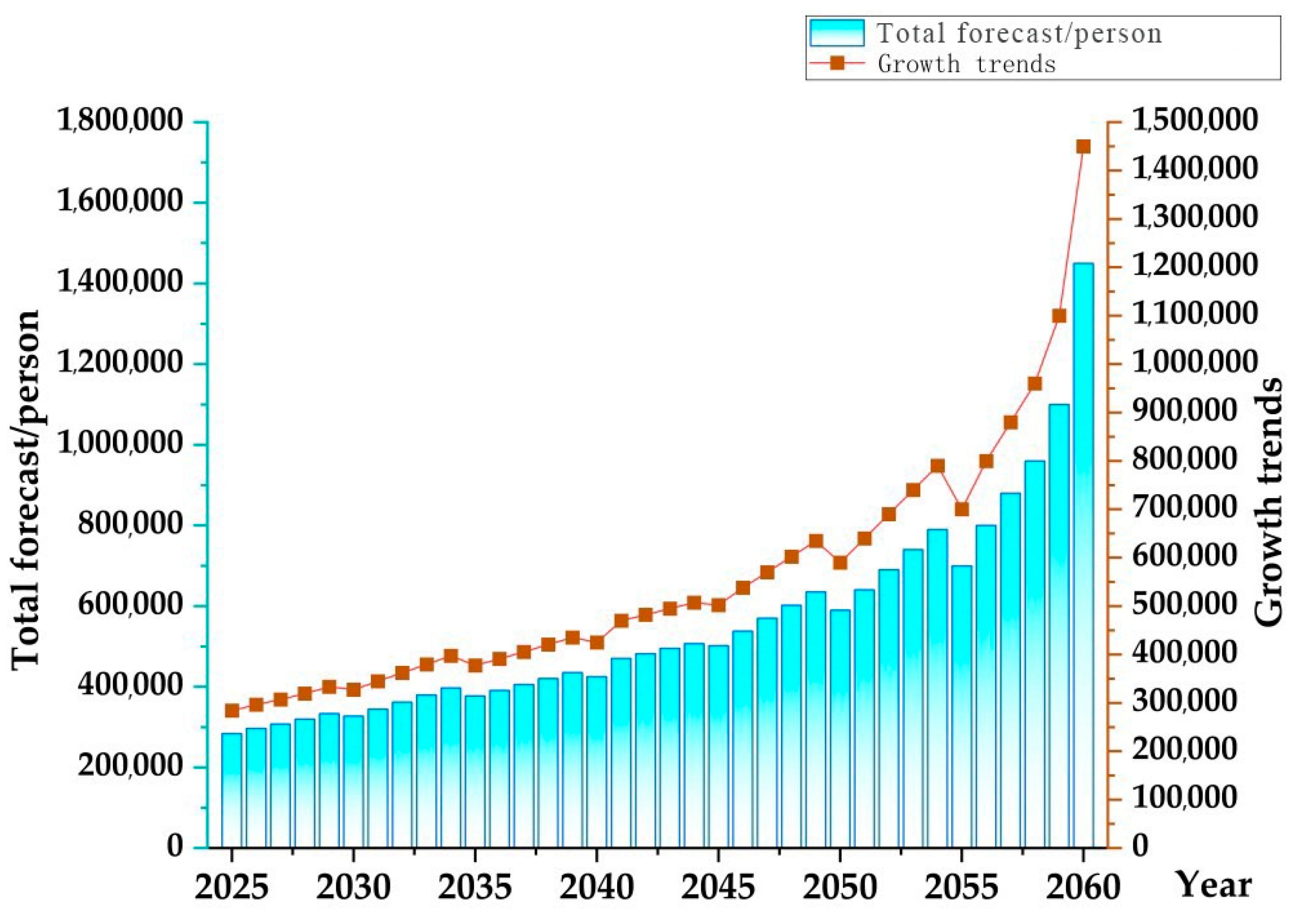Bridging the Gap: Forecasting China’s Dual-Carbon Talent Crisis and Strategic Pathways for Higher Education
Abstract
1. Introduction
2. Data Collection and Research Methodology
2.1. Data Collection
2.2. Research Methodology
3. Analysis of the Current Situation of Training and Demand for Dual-Carbon Talents in China
3.1. Current Situation of Dual-Carbon Specialized Discipline Construction
3.1.1. Analysis of Disciplines
Undergraduate Discipline Building
Graduate School Discipline Construction
3.1.2. Analysis of Professional Colleges
Undergraduate Colleges and Universities
Graduate Universities
3.2. Current Situation
3.2.1. Analysis of Demand Types
3.2.2. Quantitative Analysis of Needs
4. Forecast of China’s Dual-Carbon Talent Demand
4.1. Model Validation and Diagnostics
4.2. Forecasts of the Number of Undergraduate and Postgraduate Dual-Carbon Talents
4.3. Forecast of Total Demand for Dual-Carbon Talent
5. Discussion
5.1. Data Limitations and Missing Information
5.2. Methodological Constraints of the Gray Prediction Model
5.3. Policy–Market Synergy in Talent Cultivation
6. Conclusions and Recommendations
6.1. Conclusions
6.2. Policy Recommendations
Author Contributions
Funding
Data Availability Statement
Conflicts of Interest
References
- International Energy Agency. CO2 Emissions in 2024. 1 March 2024. Available online: https://www.iea.org/reports/co2-emissions-in-2024 (accessed on 8 April 2024).
- Yang, L.; Wang, M.; Li, L.; Yang, R. Prediction of carbon emissions of four provinces in the Yangtze River delta region based on STIRPAT model. J. Environ. Eng. Technol. 2025, 15, 81–89. [Google Scholar] [CrossRef]
- Notice of the State Council on the Issuance of the Action Plan for Reaching the Carbon Peak by 2030. Available online: https://www.gov.cn/zhengce/content/2021-10/26/content_5644984.htm (accessed on 1 January 2025).
- The Ministry of Education of the People’s Republic of China. Notice of the Ministry of Education on the Issuance of the Action Plan for Carbon-Neutral Science and Technology Innovation in Colleges and Universities. Available online: http://www.moe.gov.cn/srcsite/A16/moe_784/202107/t20210728_547451.html (accessed on 1 January 2025).
- The Ministry of Education of the People’s Republic of China. Notice on Issuing the “Work Plan for Strengthening the Talent Training System in Higher Education for Carbon Peak and Carbon Neutrality”. Available online: http://www.moe.gov.cn/srcsite/A08/s7056/202205/t20220506_625229.html (accessed on 1 January 2025).
- Boldly Assuming the Mission of Higher Education Institutions in the Journey to Build a Science and Technology Powerhouse. Available online: http://www.moe.gov.cn/jyb_xwfb/s5148/202406/t20240628_1138299.html (accessed on 1 January 2025).
- The Ministry of Education of the People’s Republic of China. Bear the Mission of Building a University in the Journey of Building a Power in Science and Technology. Available online: https://hudong.moe.gov.cn/jyb_xwfb/s5148/202406/t20240628_1138299.html (accessed on 1 January 2025).
- “Catalog of Urgently Needed and Scarce Talents in the Chengdu-Chongqing Economic Circle” Released. Available online: https://www.mohrss.gov.cn/SYrlzyhshbzb/dongtaixinwen/dfdt/202312/t20231218_510675.html (accessed on 1 January 2025).
- Cano, N.; Berrio, L.; Carvajal, E.; Arango, S. Assessing the carbon footprint of a Colombian University Campus using the UNE-ISO 14064-1 and WRI/WBCSD GHG Protocol Corporate Standard. Environ. Sci. Pollut. Res. Int. 2024, 30, 3980–3996. [Google Scholar] [CrossRef] [PubMed]
- Chang, S.Q.; Gong, Q. Discussion on Policy Implications of University Laboratories Low Carbon Const. Res. Explor. Lab. 2023, 42, 274–278+292. [Google Scholar] [CrossRef]
- Yufeng, W.; Bin, L.; Fengqi, G.; Lijun, C.; Xiucheng, Z.; Haiying, C.; Xiaohong, Z. Thoughts on Constructing and Managing the Chemistry Laboratories of Colleges and Universities in the Low-Carbon Economic Age. Res. Explor. Lab. 2010, 29, 302–304. [Google Scholar]
- Kourgiozou, V.; Commin, A.; Dowson, M.; Rovas, D.; Mumovic, D. Scalable pathways to net zero carbon in the UK higher education sector: A systematic review of smart energy systems in university campuses. Renew. Sustain. Energy Rev. 2021, 147, 111234. [Google Scholar] [CrossRef]
- Zhen, H.; Ming, J.; Hui, L. Exploration on the Construction of the “Low Carbon Technology and Management” Specialty in Universities Under the “Dual Carbon” Goal. Explor. New Humanit. Pract. 2021, 4, 60–73+142–143. [Google Scholar]
- Fang, Z.; Jingjing, S.; Qianxiu, Z. Research on the Dual Carbon Talent Training Model for the Construction Engineering Technology Major in Higher Vocational Education. J. Archit. Res. Dev. 2024, 8, 36–40. [Google Scholar]
- Ruzhi, W.; Supin, C.; Zuoren, N. Innovation of the “Four in One” Undergraduate Education Model from the Perspective of the “Dual Carbon” Goal. China Univ. Teach. 2022, 4, 14–18. [Google Scholar]
- Yangfei, J.; Yuting, X. The Path Analysis of Integrating the Green and Low Carbon Concept into the Evaluation System of Ideological and Political Work in Colleges and Universities. Forum Contemp. Educ. 2023, 3, 11–18. [Google Scholar] [CrossRef]
- Park, S.C. The EU’s strategic approach for the carbon-neutral economic system, the green deal strategy and its public governance. Int. J. Value Chain. Manag. 2023, 14, 287–308. [Google Scholar] [CrossRef]
- Juncheng, L. Analysis of the Background, Implementation, and Prospects of the European Green Deal. Master’s Thesis, Beijing Foreign Studies University, Beijing, China, 2024. [Google Scholar] [CrossRef]
- Yang, Y.; Xu, W.; Wang, Y.; Shen, J.; Wang, Y.; Geng, Z.; Wang, Q.; Zhu, T. Progress of CCUS technology in the iron and steel industry and the suggestion of the integrated application schemes for China. Chem. Eng. J. 2022, 450, 138438. [Google Scholar] [CrossRef]
- U.S. Department of Energy. Industry-Academia Collaboration in CCUS Technologies: A Case Study of Stanford-Chevron Labs; DOE Technical Report; DOE: Washington, DC, USA, 2022; DOE/EE-2543. [Google Scholar]
- Bai, X. Japan’s Green Transformation Policy and Its Implications for Higher Education. J. Glob. Sustain. 2023, 15, 45–60. [Google Scholar]
- Liu, S.F.; Deng, J.L. The Range Suitable for GM(1,1). Syst. Eng. Theory Pract. 2000, 5, 121–124. [Google Scholar]
- Zhang, S. Forecasting Talent Demand of S/M Industries and Relative Countermeasures—Taking Henan Province as an Example. J. Geomat. 2018, 43, 124–126. [Google Scholar]
- Ye, J.; Wei, M. Forecast of Demands and Analysis on Zhejiang Tourism Human Resources Based on ARIMA Mode. Adult Eduction 2014, 34, 106–108. [Google Scholar]
- Xie, N. Grey Forecast: Mechanism, Models and Applications. J. Nanjing Univ. Aeronaut. Astronaut. Soc. Sci. 2022, 24, 11–18. [Google Scholar] [CrossRef]
- Min, X. Analysis of Talent Demand Based on Grey Prediction Model GM(1,1). Sci. Technol. Manag. Res. 2005, 6, 72–74+77. [Google Scholar]
- Hu, F.; Lu, L.; Huang, B.; Zhou, W. Research on Talent Demand Forecast of High-tech Industry in Jiangsu Province: Based on Improved Metabolic GM(1,1) Model. Sci. Technol. Manag. Res. 2018, 38, 57–62. [Google Scholar]
- Zhang, H.; Jing, Q.; Zhang, Y.; Cai, W.; Gao, Q.; Li, Z.; Ji, L. Analysis of the current situation and demand forecasting of rehabilitation talents in residual connection systems based on a grey composite model. Chin. J. Health Stat. 2024, 40, 580–582. [Google Scholar]
- Jin, J.; Xu, N.; Liu, B.; Yu, J. Trend of New Energy Vehicle Industry and Prediction of Skilled Talent Demand under the Background of “Dual Carbon”. Chin. Vocat. Tech. Educ. 2024, 19, 74–84. [Google Scholar]
- He, Z.; Liu, C. Optimization of Talent Demand Forecast in Vocational Education Planning HE Zhen, LIU Chao. Mod. Educ. Manag. 2021, 1, 85–91. [Google Scholar]
- Xu, R.; Qian, G.; Lu, J.; Wang, X. Forecasting Short-term Demand for Medical and Nursing Personnel in Gansu Province Based on a Combination Model. Chin. Health Stat. 2024, 41, 287–290. [Google Scholar]
- Wang, X.; Gou, X.; Zeng, B. Optimization of Grey Combination Forecasting Model and Forecasting the Demand for Scientific and Technological Talents. West Forum 2024, 33, 94–107. [Google Scholar]
- Yao, J.; Liu, H.; Liu, J. Research on Regional Demand Trend of Scientific and Technological Innovative Talents—Prediction and Comparative Analysis based on Sichuan, Shanxi and Shanghai. Sci. Technol. Prog. Policy 2019, 36, 46–52. [Google Scholar]
- Fan, X.; Cao, Y. Demand forecasting and countermeasure analysis for high-skilled talents based on grey theory: A case study of the health technology industry cluster in Zhongshan City. Enterp. Reform Manag. 2016, 22, 37–38+98. [Google Scholar] [CrossRef]
- The Ministry of Education of the People’s Republic of China. Notice of the Ministry of Education on Doing a Good Job in Employment and Entrepreneurship for 2021 National College Graduates. Available online: http://www.moe.gov.cn/srcsite/A15/s3265/202012/t20201201_502736.html (accessed on 1 January 2025).
- The Ministry of Education of the People’s Republic of China. Notice of the Ministry of Education on Doing a Good Job in Employment and Entrepreneurship for 2022 National College Graduates. Available online: http://www.moe.gov.cn/srcsite/A15/s3265/202111/t20211119_581056.html (accessed on 1 January 2025).
- The Ministry of Education of the People’s Republic of China. Qinghai implements the ‘Dream Fulfillment Action Plan’ for vocational education. Available online: http://www.moe.gov.cn/jyb_xwfb/s5147/202111/t20211130_583341.html (accessed on 1 January 2025).








| Undergraduate Student | Postgraduate Student | |
|---|---|---|
| Institutional Level | Number of Counts | Number of Counts |
| 985 university | 36 | 39 |
| 211 university | 42 | 60 |
| double first-class university | 11 | 12 |
| double non-university | 269 | 226 |
| total | 358 | 337 |
| Year | 2019 | 2020 | 2021 | 2022 | 2023 | 2024 |
|---|---|---|---|---|---|---|
| Number of undergraduates | 212,750 | 227,850 | 230,445 | 243,765 | 253,875 | 261,120 |
| Number of graduate students | 13,198 | 17,043 | 20,917 | 24,600 | 27,392 | 27,793 |
| Total number | 225,948 | 244,893 | 251,362 | 268,365 | 281,267 | 288,913 |
| Year | 2019 | 2020 | 2021 | 2022 | 2023 | 2024 |
|---|---|---|---|---|---|---|
| Number of undergraduates | 199,985 | 214,179 | 216,618 | 229,139 | 238,643 | 245,453 |
| Number of postgraduate students | 124,07 | 16,021 | 19,663 | 23,125 | 25,748 | 26,126 |
| Total number | 212,392 | 230,200 | 236,281 | 252,264 | 264,391 | 271,579 |
| Index Term | Year | x(1)(k) | σ(1)(k) | Meets [1, 1.5] |
|---|---|---|---|---|
| Undergraduates | 2020 | 414,164 | 2.07 | not (>1.5) |
| 2021 | 630,782 | 1.52 | not (>1.5) | |
| 2022 | 859,921 | 1.36 | yes | |
| 2023 | 1,098,564 | 1.28 | yes | |
| 2024 | 414,164 | 1.22 | yes | |
| Postgraduate students | 2020 | 28,428 | 2.29 | not (>1.5) |
| 2021 | 48,091 | 1.69 | not (>1.5) | |
| 2022 | 71,216 | 1.48 | yes | |
| 2023 | 96,964 | 1.36 | yes | |
| 2024 | 123,090 | 1.27 | yes |
| Index Term | Year | Original Value | Predicted Value | Residuals | Relative Error (%) | MAPE |
|---|---|---|---|---|---|---|
| Undergraduates | 2019 | 199,985 | 199,985 | 0 | 0 | 0.653% |
| 2020 | 214,179 | 212,152.802 | 2026.198 | 0.946 | ||
| 2021 | 216,618 | 220,157.045 | −3539.045 | 1.634 | ||
| 2022 | 229,139 | 228,463.277 | 675.723 | 0.295 | ||
| 2023 | 238,643 | 237,082.893 | 1560.107 | 0.654 | ||
| 2024 | 245,453 | 246,027.715 | −574.715 | 0.234 | ||
| Graduate students | 2019 | 12,407 | 12,407 | 0 | 0 | 1.948% |
| 2020 | 16,021 | 17,385.919 | −1364.919 | 8.52 | ||
| 2021 | 19,663 | 19,491.588 | 171.412 | 0.872 | ||
| 2022 | 23,125 | 21,852.281 | 1272.719 | 5.504 | ||
| 2023 | 25,748 | 24,498.887 | 1249.113 | 4.851 | ||
| 2024 | 26,126 | 27,466.032 | −1340.032 | 5.129 |
| Index Term | Year | Residuals | ADF | ARIMA Order Determination |
|---|---|---|---|---|
| Undergraduates | 2019 | 0 | p = 0.02 | ARIMA(1,0,1) |
| 2020 | 2026.198 | |||
| 2021 | −3539.045 | |||
| 2022 | 675.723 | |||
| 2023 | 1560.107 | |||
| 2024 | −574.715 | |||
| Graduate students | 2019 | 0 | p = 0.03 | ARIMA(1,1,1) |
| 2020 | −1364.919 | |||
| 2021 | 171.412 | |||
| 2022 | 1272.719 | |||
| 2023 | 1249.113 | |||
| 2024 | −1340.032 |
| Index Term | Year | GM Predicted Value (Persons) | ARIMA Residual Correction (Persons) | Mixed Model Predictions (Persons) | Annual Growth Rate |
|---|---|---|---|---|---|
| Undergraduates | 2025 | 252,300 | 1200 | 253,500 | 2.90% |
| 2030 | 290,500 | −3800 | 286,700 | 2.30% | |
| 2040 | 375,000 | −12,500 | 362,500 | 1.80% | |
| 2050 | 485,000 | −25,000 | 460,000 | 1.30% | |
| 2060 | 625,000 | −40,000 | 585,000 | 0.90% | |
| Postgraduate students | 2019 | 12,407 | 12,407 | 0 | 0 |
| 2020 | 16,021 | 17,385.919 | −1364.919 | 8.52 | |
| 2021 | 19,663 | 19,491.588 | 171.412 | 0.872 | |
| 2022 | 23,125 | 21,852.281 | 1272.719 | 5.504 | |
| 2023 | 25,748 | 24,498.887 | 1249.113 | 4.851 |
| Index Term | Original Value | Predicted Value | Residuals | Relative Error (%) | MAPE |
|---|---|---|---|---|---|
| 2019 | 212,392 | 212,392 | 0 | 0 | 0.584 |
| 2020 | 230,200 | 228,168.802 | 2031.198 | 0.882 | |
| 2021 | 236,281 | 239,495.426 | −3214.426 | 1.36 | |
| 2022 | 252,264 | 251,384.319 | 879.681 | 0.349 | |
| 2023 | 264,391 | 263,863.393 | 527.607 | 0.2 | |
| 2024 | 271,579 | 273,511.105 | −1932.105 | 0.711 |
| Index Term | Year | X(2)(k) | σ(2)(k) | Meets [1, 1.5] |
|---|---|---|---|---|
| Undergraduates | 2020 | 414,164 | - | - |
| 2021 | 1,044,946 | 2.52 | not (>1.5) | |
| 2022 | 1,904,867 | 1.82 | not (>1.5) | |
| 2023 | 3,003,431 | 1.58 | yes | |
| 2024 | 4,347,448 | 1.45 | yes | |
| Postgraduate students | 2020 | 40,835 | 3.29 | not (>1.5) |
| 2021 | 88,926 | 2.18 | not (>1.5) | |
| 2022 | 160,142 | 1.8 | not (>1.5) | |
| 2023 | 257,106 | 1.61 | yes | |
| 2024 | 380,196 | 1.48 | yes |
Disclaimer/Publisher’s Note: The statements, opinions and data contained in all publications are solely those of the individual author(s) and contributor(s) and not of MDPI and/or the editor(s). MDPI and/or the editor(s) disclaim responsibility for any injury to people or property resulting from any ideas, methods, instructions or products referred to in the content. |
© 2025 by the authors. Licensee MDPI, Basel, Switzerland. This article is an open access article distributed under the terms and conditions of the Creative Commons Attribution (CC BY) license (https://creativecommons.org/licenses/by/4.0/).
Share and Cite
Li, S.; Li, S.; Li, J.; Yuan, L.; Geng, J. Bridging the Gap: Forecasting China’s Dual-Carbon Talent Crisis and Strategic Pathways for Higher Education. Sustainability 2025, 17, 7190. https://doi.org/10.3390/su17167190
Li S, Li S, Li J, Yuan L, Geng J. Bridging the Gap: Forecasting China’s Dual-Carbon Talent Crisis and Strategic Pathways for Higher Education. Sustainability. 2025; 17(16):7190. https://doi.org/10.3390/su17167190
Chicago/Turabian StyleLi, Shanshan, Shoubin Li, Jing Li, Liang Yuan, and Jichao Geng. 2025. "Bridging the Gap: Forecasting China’s Dual-Carbon Talent Crisis and Strategic Pathways for Higher Education" Sustainability 17, no. 16: 7190. https://doi.org/10.3390/su17167190
APA StyleLi, S., Li, S., Li, J., Yuan, L., & Geng, J. (2025). Bridging the Gap: Forecasting China’s Dual-Carbon Talent Crisis and Strategic Pathways for Higher Education. Sustainability, 17(16), 7190. https://doi.org/10.3390/su17167190







